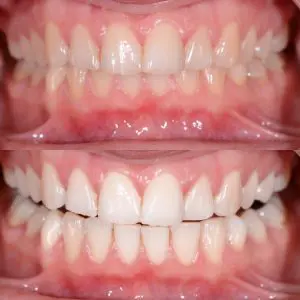
TEETH WHITENING
In modern societies, individuals care about the appearance of their teeth. In fact, irregularities in the shape and color of teeth can even lead to psychological issues. Thanks to advancements in aesthetic and restorative materials in dentistry, many color, shape, and position irregularities can now be easily corrected. Whitening discolored teeth (bleaching) is a more affordable, practical, and harmless solution compared to other restorative methods.
What is the whitening (bleaching) process, and how is it done?
Whitening is the process of removing discoloration that occurs in the tooth structure (enamel and dentin layers). Currently, two different whitening methods are known. The first one is a method that patients can apply on their own, and the steps are as follows:
- The dentist takes an impression of the teeth and prepares thin rubber trays that fit over them.
- The patient places the whitening gel inside the custom-made tray and wears it over the discolored teeth for at least 6–8 hours a day (preferably during sleep).
- The treatment is usually completed within 1–4 weeks.
The second method is performed by a dentist in the clinic and follows these steps:
- A bleaching agent is applied to the teeth by an experienced dentist.
- A white light source is directed at the treated teeth for a certain period.
- The results are immediately visible after the procedure.
Both methods are effective, but the choice depends on the degree of discoloration, how quickly the treatment needs to be completed, and the dentist’s recommendation.
What causes unwanted stains on teeth?
There are many reasons for tooth discoloration. The most common ones include aging, consumption of stain-causing substances (coffee, tea, cola, smoking, etc.), trauma, old prosthetics, crowns, and fillings. The use of antibiotics (such as tetracycline) or excessive fluoride consumption during tooth development can also lead to discoloration. These stains can be due to intrinsic factors, external staining agents, antibiotic or fluoride intake during childhood, aging, or trauma to the tooth.
Who can undergo the whitening procedure?
Almost everyone! However, there are certain cases where the treatment may not be effective. Your dentist will conduct a complete oral examination to determine if your teeth are suitable for whitening. If your teeth are healthy, it is an ideal solution for a brighter and more natural smile.
Is the whitening process difficult or uncomfortable?
No! Thanks to advancements in oral health technology, teeth can be whitened in a very short time safely and effectively.
Is it safe?
Yes! According to research, teeth whitening is extremely effective and safe when performed under the supervision of a dentist. The teeth and gums do not suffer any damage.
How long does the procedure take?
In general, whitening begins with the first application. However, to achieve the ideal appearance, the procedure should continue for 10–14 days.
Will the teeth return to their original color after whitening?
The teeth will always be whiter than before. However, depending on the patient’s habits and oral care, a touch-up treatment may be needed once or twice a year.
If you smoke, you should avoid smoking while wearing the whitening tray (applies to at-home whitening). A mild sensitivity to hot and cold may occur, but it will disappear after the treatment is completed.
